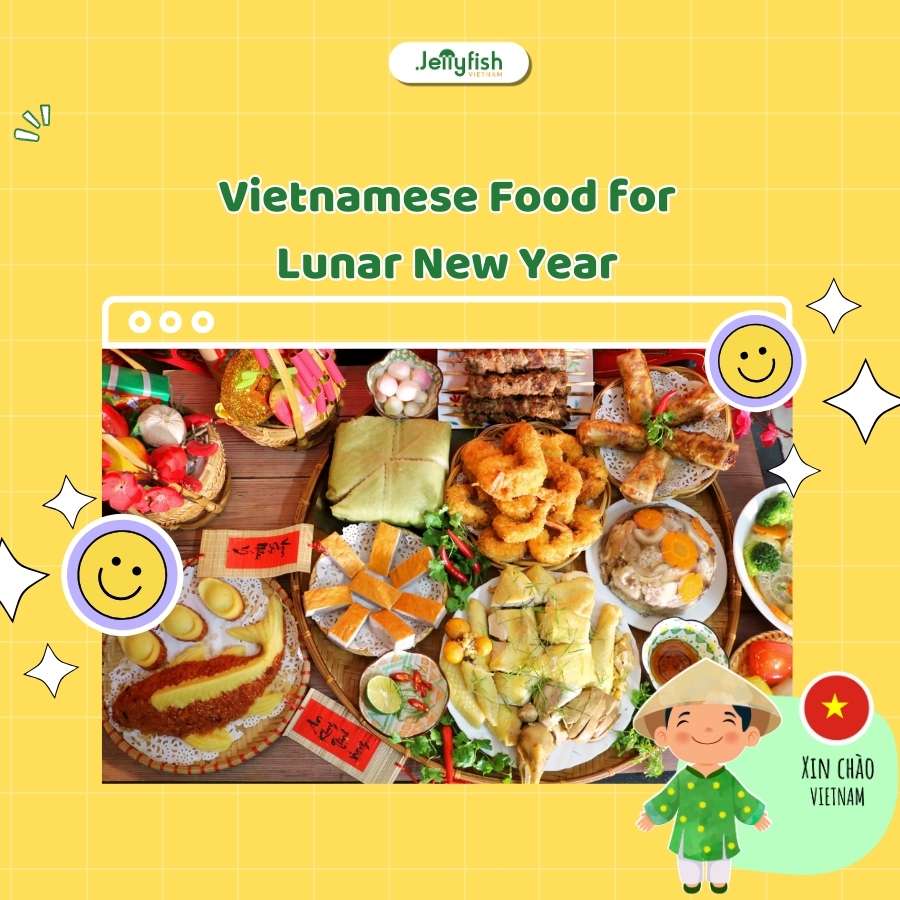In Vietnam, Lunar New Year (Tết) is the most important holiday of the year, a time for family, traditions, and of course, food. Meals shared during Tết are rich in symbolism, flavor, and cultural meaning. In this article, Jellyfish introduces the most iconic Vietnamese food for Lunar New Year, helping you understand the stories behind each dish and why they matter during this festive season.
1. Bánh Chưng and Bánh Tét: The Stars of the table
No Vietnamese food for the Lunar New Year list would be complete without mentioning these iconic rice cakes.
- Bánh chưng (square) is popular in northern Vietnam
- Bánh tét (cylindrical) is common in central and southern regions
Both are made from sticky rice, mung beans, and pork, wrapped in green leaves (usually dong or banana) and boiled for hours. They represent:
- Earth and sky (square = Earth, cylinder = sky)
- Gratitude to ancestors
- Wishes for abundance and unity
Families often gather to wrap and cook bánh chưng together — a tradition passed down through generations.

2. Pickled vegetables (dưa món, dưa hành)
Pickled foods are essential Vietnamese food for Lunar New Year, served to balance the richness of meat and rice cakes.
- Dưa món: A colorful mix of carrots, daikon, papaya, and more, pickled in sweet fish sauce
- Dưa hành: Pickled shallots or onions, especially popular in the north
These crunchy, tangy sides are believed to cleanse the body and bring balance to the feast. They’re often served with bánh chưng or boiled pork.
3. Boiled chicken (gà luộc): A Symbol of prosperity
Boiled chicken, often served whole with golden skin and dipped in salt-lime-pepper — is a staple offering on ancestral altars during Tết.
Why it matters:
- Symbolizes purity, respect, and new beginnings
- Often used in ceremonies to invite ancestors to celebrate the new year
- Paired with sticky rice and pickled vegetables
Gà luộc is a simple yet meaningful part of Vietnamese food for Lunar New Year, representing both spiritual connection and shared blessings.

4. Thịt kho trứng (Braised pork with eggs)
In southern Vietnam, thịt kho trứng is a must-have during the Tết holiday.
This dish features:
- Pork belly and boiled eggs
- Braised in coconut juice and fish sauce
- Cooked until caramelized and tender
It’s often eaten with white rice or sticky rice. Symbolically:
- Eggs represent completeness
- Pork reflects generosity and comfort
This hearty, savory dish is cooked in large batches to last several days, making it both practical and festive
5. Xôi (Sticky rice variations)
Sticky rice, or xôi, appears on nearly every Tết table across Vietnam. Common types include:
- Xôi gấc: Red sticky rice made with baby jackfruit pulp — a lucky color for the new year
- Xôi đậu xanh: Sticky rice with mung beans
- Xôi lạc: Sticky rice with peanuts
Sticky rice symbolizes togetherness, prosperity, and good fortune. It’s often served with boiled chicken or bánh chưng for a balanced, celebratory meal.
6. Chè (Vietnamese sweet soups and desserts)
No celebration is complete without dessert, and chè is a favorite way to end a Tết meal. Popular types include:
- Chè kho: A thick mung bean dessert, common in the north during Tết
- Chè trôi nước: Glutinous rice balls with mung bean filling, served in sweet ginger syrup
- Chè ba màu: Three-colored dessert with beans, jelly, and coconut milk
These desserts are often shared with guests as a sweet way to start the new year.
7. Fruits and seeds: A feast of symbolism
During Tết, fruit trays (mâm ngũ quả) are placed on the altar to honor ancestors and invite good fortune. Common fruits and snacks include:
- Custard apple, coconut, papaya, and mango: Each name sounds like a wish for wealth or happiness
- Watermelon: Red flesh brings luck
- Roasted watermelon seeds: A crunchy snack for gatherings
These aren’t just for display — they’re also part of the joyful snacking and hospitality during Tết.

Exploring about: Lunar new year of Viet Nam
Conclusion
From sticky rice cakes to pickled vegetables and symbolic desserts, Vietnamese food for Lunar New Year is a delicious reflection of love, culture, and spiritual connection. Each dish has a story — whether it’s honoring the past, welcoming prosperity, or simply gathering with loved ones around a warm meal.
Celebrate Vietnamese Culture with Jellyfish
Want to understand more about Vietnamese holidays, family values, and food traditions? At Jellyfish, we offer Vietnamese language and cultural courses for learners around the world.
- Explore Tết traditions through language and stories
- Learn real conversation and vocabulary related to food and celebration
- Join online or in-person classes with native teachers
👉👉 Learning Vietnamese – Jellyfish Vietnam
✦ Hotline: 096 110 6466
✦ Head office: 1st Floor, Web3 Tower Building, Alley 4 Duy Tan Street, Cau Giay District, Hanoi
✦ Branch office: Sholega building, 275 Lach Tray, Ngo Quyen, Hai Phong
✦ Head office in Japan: 4F Westhill Building, Nishigotanda 2-24-4, Shinagawa, Tokyo, Japan


